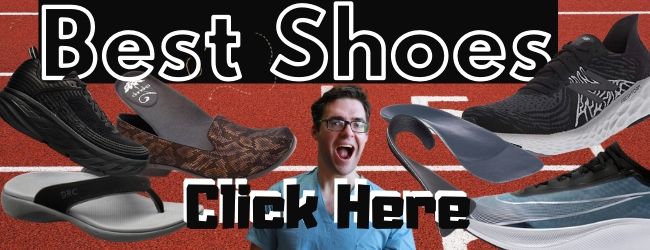Best Shoes & Best Insoles
Foot Corn Removal Surgery [Causes & Best Treatment]
Foot corn removal surgery is not needed 95+% of the time. So you are in luck! Follow our foot corn removal process today!
Look!
- Corns can be really painful!
- Some early options are great shoes & seeing a podiatrist.
- We also offer our video thoughts below!
If you finally do need foot corn surgery, Let us HELP!
Table of Contents
How to remove corn from foot treatment video:
Foot Corn Removal Surgery is designed to wipe out highly resistant foot corns after conservative treatment has failed.
What Is It?
- Foot corns are painful formations of thick skin on the foot and toes that look like a hard pebble.
- Many people can even form a corn within a callus. This is a hard pebble surrounded by a softer callus over top of it.
- There are many reasons and theories for why corns with calluses occur, but there is no point getting into it because the treatments are all the same!
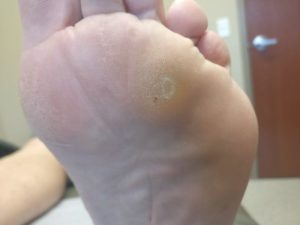
Why does it hurt?
- Pain occurs from the corns and calluses because as you walk on them, they tear away from the skin underneath them, and it is possible to form a callus blister and even ulceration underneath them.
- The goal of treatment is to reduce both corns and calluses and keep them soft and eventually remove the deformity or biomechanical problem that is causing them.
- Foot Corn Surgery is rarely needed, but usually, foot corn is highly effective and prevents the corns from ever coming back.
Foot Corn (aka Heloma) vs Callus:
- Corns are a form within the skin underneath the pressure areas of the foot, especially the toes. Skin callus formation can be large and spread out, whereas a corn is pinpointed, small and hard.
- Corns usually occur under the first toe, the fifth toe, and on top of the toes if you have hammertoes, whereas a callus is usually underneath the forefoot.
- Both can occur together- it is necessary to take the callus down then pop out the corn.
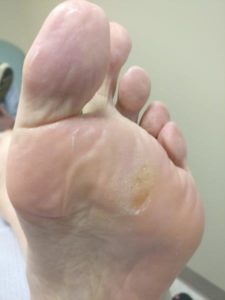
Corn vs. Wart:
- Skin lines go through a callus, whereas the skin lines go around the wart if you have a wart. The plantar wart also displays tiny red “dots” that are blood vessel growth into the wart. The callus should not have any red “dots.”
- A corn will be lodged beneath the outer layers of the callus.
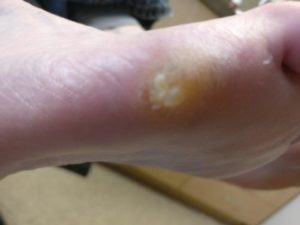
Without trimming this down, it is hard to tell whether it is a corn or a wart.
Causes:
- Walking barefoot or in poorly stitched shoes.
- Wearing loose shoes or sandals.
- High heels can cause pressure or friction.
- High arched feet form calluses under the first toe, fifth toe, and heel.
- A flat foot is a primary cause of increased pressure in areas of the foot, especially everywhere in the forefoot and inside of the foot and heel.
- Rubbing in the tops of the toes against a tight shoe is also a leading cause of corn formation in the toes.
Symptoms:
- Corn usually feels like a hard pebble stuck to your toes or in between the toes.
- With continued pressure, it may feel like you are walking on a rock.
- This may lead to bruising.
- This may lead to numbness, burning, and tingling.
- The more you walk on it, the more you may feel pain in pressure areas of your feet.
Diagnosis:
- Your podiatrist can usually diagnose your foot corns and calluses by looking at them through a physical exam.
- An x-ray may be ordered to rule out other underlying changes.
- If the corner callous does look suspicious, your podiatrist may elect to perform a biopsy.
- The main purpose of soft tissue biopsy is to rule out any further dangerous possibilities. This is usually a meager percentage chance of something dangerous occurring. But it is better to be safe than sorry.
Home Prevention
- Get your foot size measured properly- check the width, the length, and the arch length. It is essential to have a wide toe box and an extra half size in the front of your shoe for your toes to wiggle. Avoid shoe gear pressing the fourth and fifth toes together.
- You can use Jill’s footpads between your toes and around the calluses to prevent them from shearing against the shoe.
- Foam or moleskin pads cut out around the callus and corn in a circle shape, preventing shearing force against the corn.
- Change from cotton socks! Synthetic socks like those made from polyester are great for summer because they do not absorb sweat like cotton socks. This prevents skin friction and callus/corn formation. Synthetic wool socks are perfect for the winter because they keep you warm and prevent absorbing sweat.
- You can put vaseline or petroleum oil in the areas where friction is most likely to occur or if you already have callus formation. Combine this method with the socks, and the callus pain should be dramatically decreased.
- The calluses and corns need to be thinned down through the next section’s methods to prevent pain.
Treatment of Skin Calluses with Salicylic Acid
- It is a “keratolytic” that kills the callus and turns it into a peeling dead skin that is more easily removed by debriding agents like an emery board or a pumice stone.
- This may result in penetration of the skin.**Be careful if you have frail skin. You must use an antibiotic ointment and see a doctor immediately.
Home Treatment:
- Soak your feet! It is straightforward to soak your feet and then grind away the skin with a pumice stone or an emery board. Soak your feet for at least fifteen to thirty minutes. It is possible to add Epsom Salts to improve the results.
- The above point can be supplemented by applying salicylic acid to your skin callus after soaking. Try salicylic acid at night for a few nights to see if it decreases callus formation. Most commercial products rely on salicylic acid, and the process is detailed above.
- Aloe Vera, Cocoa Butter, or Lotions + Socks is also perfect for calluses. Apply the agent of choice to the calluses when you go to bed at night, and over a few days, the calluses should start to decrease, and the socks should keep your sheets clean.
- Use an emery board or a pumice stone can then be used to remove the callus for faster results.
- If there is significant pain or tenderness after treating this would site, an antibiotic medication in case you cause bleeding or tear the skin.
- Use gel pads for calluses between the toes. A bandaid can work, but there are fantastic products such as gel pads that will make your pain disappear, and you won’t even know that they are there. Jill’s footpads are available at most pharmacies and are very cheap.
- Change from cotton socks! Synthetic socks like those made from polyester are great for summer because they do not absorb sweat like cotton socks. This prevents skin friction and callus/corn formation. Synthetic wool socks are perfect for the winter because they keep you warm and prevent absorbing sweat.
- You can put vaseline or petroleum oil in the areas where friction is most likely to occur or if you already have callus formation. Combine this method with the socks, and the callus pain should be dramatically decreased.
- Note: These can all be temporary methods if the callus is still tender. Seeing a podiatrist correct the deformity thorough biomechanical evaluation and X-ray to see something underneath the callus or corn.
When to see a podiatrist for Foot Corn Removal Surgery.
- Get a biomechanical exam to determine why the corn continues to appear.
- If the corn & callus is removed and the pain is still there for a long time means that you likely have a deformity in that area, and it may need to be surgically corrected.
- All of the above methods are only temporary treatments. Skin calluses are usually due to a deformity that would need to be corrected.
- Surgery is usually unnecessary unless there is a bone deformity, such as a hammertoe or a bunion. The calluses and corns will usually keep re-appearing if this problem is not corrected.
For more on Foot Corn Removal Surgery:
http://en.wikipedia.org/wiki/Corn_(medicine)
Home Treatment Products:
- These are our favorite corn and callus prevention products.
- The real key is to get pressure off the sites that create corns and calluses.
- A podiatrist can help you trim out the corn in the callous initially, but with great products, this could reduce the likelihood of any more from developing.
Best Gel Pads:
- These are the best gel pads.
- These can work really well for hammertoes but don’t reverse the shape.










Get Great Shoes:
- Getting a great supportive pair of shoes will make sure that there is pressure removed from your hammertoes.
- This can prevent corns, calluses, and spur formation.
- This is especially important if you have plantar fasciitis, flat feet, or weak ankles.
- Consider shoes combined with good supportive orthotics for the best pain relief!
- The following link will show you what our favorites are.
The real key to fix outside of the foot pain in order:
1) Most important is a good orthotic for your shoe.
- Give these 1-2 weeks of effort, and you will really notice the pain relief.
- This does not instantly fix the pain but prevents future damage.
2) Gel pad to offload the toe.
- This will give your toes some cushion to keep pressure off the toes.
- Read below to see the specific gel pads for each specific condition.
3) Ankle brace for the possible correction.
- Check the recommended braces below.
- For ankle pain, this is almost guaranteed to improve your problem.
4) Menthol-based cream for pain relief.
- Creams and gels like Biofreeze act like ice but save you 20 minutes!
- Check below for our recommended pain relief options.
Pain Relief:
- Menthol-based creams have been studied medically, and shoe safety and excellent results.
- This is not fluff. These are scientifically-backed!
- Biofreeze is cost-effective and shows great results.
- This is more for people who have difficulty sleeping or walking due to significant issues.








Best Orthotics:
Our Recommended Orthotics To Stop Outward Compression:
- Orthotics are the single most important way to improve your outside of the foot pain, Seriously!
- Most people don’t think orthotics will fix their foot pain.
- Besides trauma, 95% of all 5th toe, middle of the foot, and outside of the ankle pain can be improved with orthotics.
- This is because orthotics help your foot from twisting out and compressing against your shoe when you walk.
- Would you please not take our word for it? Read the reviews!
Most Important Tips For Orthotics:
- Make sure you have a roomy enough shoe.
- I’m warning you right now, don’t try to stuff a full-length orthotic into a tiny tight shoe. It won’t work.
- If you have tighter or dress shoes: try the dress shoe or 3/4″ orthotics.
These orthotics are for slimmer shoes without laces:
- If you are tight in the front of your shoes, or the shoes are tighter, these 3/4″ might be the best choice for you.
- But if you have a choice, the full-length orthotics are much, much more supportive!
- So if you wear work boots or running shoes, get the full length. They get you more support.








Full-length orthotics give you the most correction and improvement:
- If you have roomy enough shoes like running shoes or work boots. Get a full-length orthotic.
- The cushion under the front of your foot prevents it from twisting out against the outside of your shoe as much as possible.
- These are one of the best possible options for the medium and heavy-duty correction!


Dress Shoe orthotics:
- These are premium leather orthotic recommendations for dress shoes.
- If you have a tight dress shoe get the 3/4″ orthotic.






Other in-office surgeries our podiatrists provide:
We can perform toenail, toe, foot, heel & ankle surgery in the office!
We can help with:
- Minimally invasive foot surgery.
- Minimally invasive bunion surgery.
- Minimally invasive hammertoe surgery.
- Corn and callus removal surgery.
- Plantar wart removal surgery.
- In-office permanent ingrown toenail removal surgery.
- Removal of unwanted spurs, bumps, or lumps on your feet.
- Shockwave therapy (AKA ESWT therapy or EPAT therapy)
- Cold laser therapy.
- MLS laser therapy (Multi-Wave Locked System laser therapy).
- Laser for peripheral neuropathy.
- 3D custom orthotic scan.
Best Shoes & Best Insoles
Balance Foot & Ankle, Howell, Michigan
Balance Foot & Ankle, Bloomfield Hills, Michigan
Balance Home Care & Wound Care
11 Reasons To Choose US!
- 🥇 We work hard for YOUR Satisfaction. (If you’re not 100% satisfied with your appointment, we WILL do everything we can to FIX IT for you.) Terms & Conditions.
- 🦶The BEST Podiatrists: Board Certified in Foot Surgery & Board Certified in Podiatric Medicine for all of your foot & ankle needs!
- 💻Telehealth appointment from the comfort of your own home!
- 🚗 You Can Park 100% for Free Right Outside The Door.
- 📲 You Can Book Online 24/7 Right From Your Phone.
- 🌙 You Can Get A Late Appointment Or Seen Outside of Regular Hours……No Need To Take Time Off Work.
- 🏠 If you cannot come to see us due to health issues or immobility… We can come to see YOU!
- 💉 The BEST Tools: In-office X-ray, In-office fluoroscopy, In-office ultrasound, injections, skin treatment, and in-office surgical suite. We are trained to use the NEWEST equipment.
- 📞 You Can Take Up Our Offer for a Phone or Telehealth Consult With Our Podiatry Team before you arrive if you are unsure if we can help you.
- 🏥 A professional cutting edge surgical suite staffed by residency trained Board Certified Foot & Ankle Surgeons: Minimally Invasive Surgery!
- 👣You Get Treated By Podiatrists Who Specialize In the Foot & Ankle, So They KNOW What’s Needed To Get You Back On Your Feet.
Google Rating
Prime Foot & Ankle Specialists - Podiatrists & Foot Doctors
4.9 341 reviews
-
Alex Hyman
★★★★★
3 months ago
Just watched a youtube video on "Cuboid Syndrome Treatment" by Michigan Foot Doctors and I think the suggested … More treatment in the video has almost instantly healed my foot!
-
Doug Gosa
★★★★★
5 months ago
Amazingly thorough! Astoundingly effective results! If you’re in their area - they need to be your people!!!
-
Joseph Russo
★★★★★
a year ago
I'm 54 years old, and I'm always enlighten by the info I get from this channel. We can never stop learning to better … More our health.
Free BOOK to solve foot pain:
STOP wasting TIME & MONEY on your foot & ankle pain!
“11 SIMPLE Ways to STOP Foot PAIN. “
Learn 11 simple step-by-step tips to get rid of foot & ankle pain… even if you’ve suffered for months or years and your doctor told you nothing could be done to help!
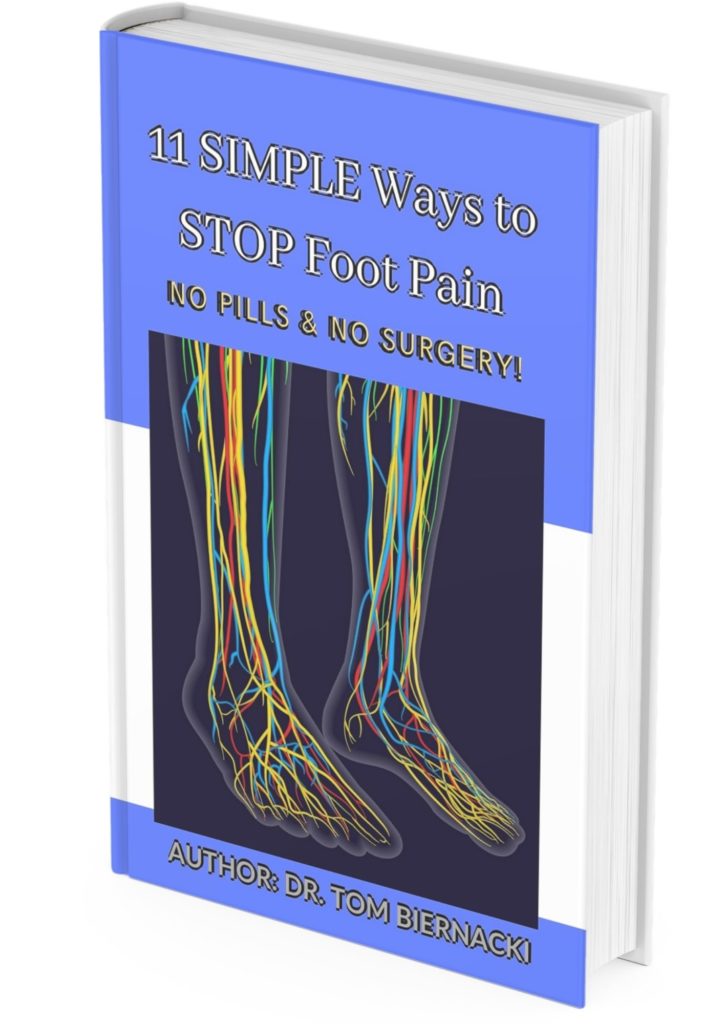
Frustrated With Your Foot Pain? Let Us Help!
Not sure what to do?
Not sure who to ask?
- If you live in Michigan, we can HELP!
Fill in the form, and one of our highly qualified team will be in touch to discuss your specific problem.
What a Podiatrist Can Do For YOU!
